
“
Beyond the Milky Way: Imagining New Worlds and Possibilities
Introduction to the Cosmos
Beyond the Milky Way: Imagining New Worlds and Possibilities is an exciting topic that has captured human imagination for centuries. The idea of exploring the vastness of the universe, beyond our own galaxy, is a fascinating concept that has sparked the interest of scientists, philosophers, and science fiction writers alike. As we continue to advance in our technological capabilities and space travel, the possibility of discovering new worlds and encountering new forms of life becomes increasingly likely.
The Milky Way, our home galaxy, is just one of billions of galaxies in the observable universe. It is estimated that there are over 100 billion galaxies in the universe, each containing billions of stars and potentially, countless planets. The sheer scale of the universe is almost incomprehensible, and yet, it is this vastness that makes the possibility of discovering new worlds and life beyond our own galaxy so intriguing.
The Search for New Worlds
The search for new worlds and possibilities beyond the Milky Way is an ongoing effort that has been driven by human curiosity and the desire to explore and understand the universe. From the early astronomers who first gazed up at the night sky, to the modern-day space agencies and private companies that are pushing the boundaries of space travel, the quest to discover new worlds has been a constant theme throughout human history.
One of the most significant breakthroughs in the search for new worlds has been the discovery of exoplanets. Exoplanets are planets that orbit stars outside of our own solar system, and they offer a tantalizing glimpse into the possibility of life beyond our own planet. To date, thousands of exoplanets have been discovered, and many of these planets are believed to be located in the habitable zones of their respective stars, where the conditions are suitable for life as we know it.
Imagining New Possibilities
As we continue to explore the universe and discover new worlds, we are also forced to imagine new possibilities for human existence and space travel. The idea of establishing colonies on other planets, or even traveling to other galaxies, is no longer the realm of science fiction, but a real possibility that is being considered by scientists and engineers. For more on this topic, check out Soaring Through the Cosmos: The Power of Imagination Beyond the Stars.
One of the most significant challenges that we face in our quest to explore the universe is the vast distance between stars and galaxies. Even at high speeds, such as those achieved by the Voyager spacecraft, it would take tens of thousands of years to reach the nearest star outside of our solar system. However, scientists are exploring new technologies, such as fusion propulsion and gravitational manipulation, that could potentially allow us to travel vast distances in a much shorter period.
Conclusion and Takeaways
In conclusion, the idea of exploring the universe beyond the Milky Way is a captivating concept that has sparked human imagination for centuries. As we continue to advance in our technological capabilities and space travel, the possibility of discovering new worlds and encountering new forms of life becomes increasingly likely. For further insights, consider reading Cosmic Creativity: How Imagination Soars Beyond the Constellations.
Some key takeaways from this article include:
- The universe is vast and contains billions of galaxies, each with billions of stars and potentially, countless planets.
- The search for new worlds and possibilities beyond the Milky Way is an ongoing effort that has been driven by human curiosity and the desire to explore and understand the universe.
- Exoplanets offer a tantalizing glimpse into the possibility of life beyond our own planet, and many of these planets are believed to be located in the habitable zones of their respective stars.
- Establishing colonies on other planets, or even traveling to other galaxies, is no longer the realm of science fiction, but a real possibility that is being considered by scientists and engineers.







